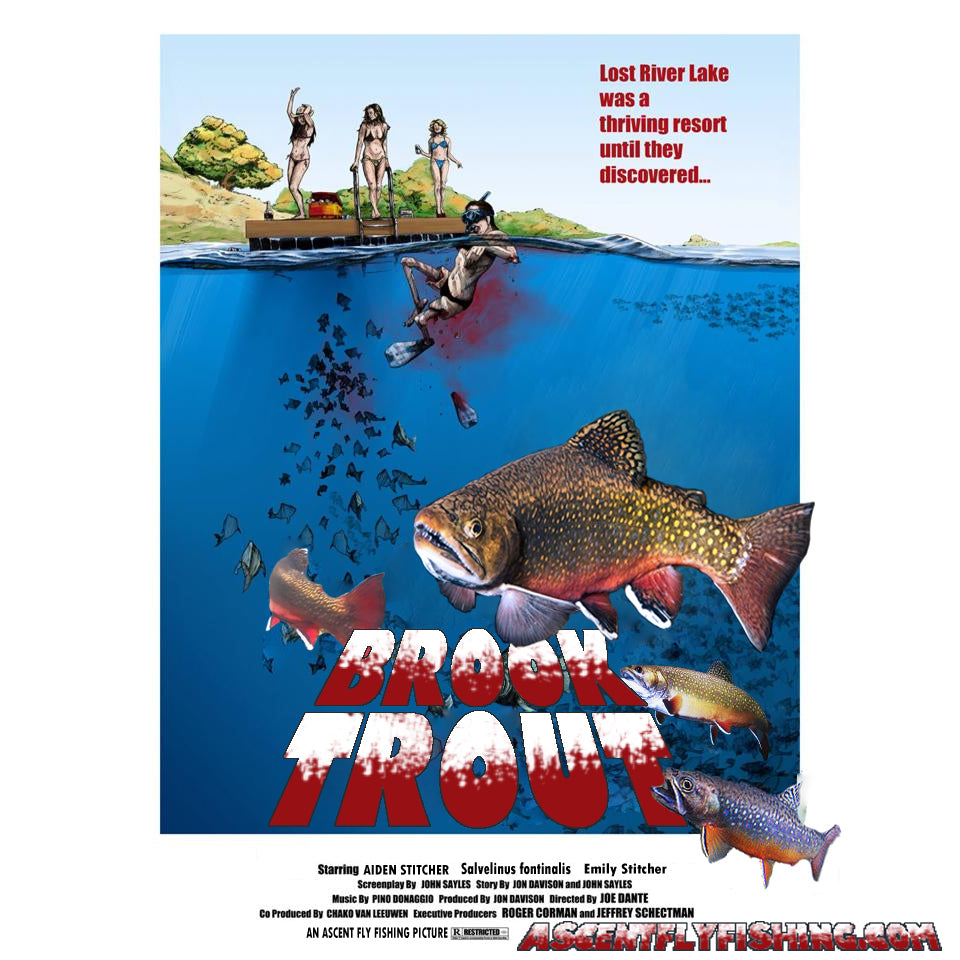
Trout Smart Series: An Insider's Look at Catching Brook Trout on the Fly

It was a beautiful day on the lake. The kids were splashing happily in the shallows while dad lazily cast a dry fly from the dock with a cold beer close at hand. Little did they know that there was a menace lurking just beneath the surface of the water. Beady little eyes set above rows of sharp teeth, menace coiling in their their bodies, a school of dark shapes began to ascend from the deep. Just then a shrill scream echoes out across the lake. In panic, the kids flood for the shore, leaving each to fend for themselves. Perplexed, they look for the source of the scream only to find their father visibly shaken and sitting squarely in the middle of the dock, hand trembling, with frayed tippet clenched in bloodless white fingers. “It all happened so fast,” he said in shocked incredulity. ”I didn’t even see them coming! My dry fly was on the surface of the water, and then it was gone... it was just gone! (sobbing)” The Brook Trout had struck again!
In part II of our Trout Smart series we will be breaking down a familiar adversary to many of us: Salvelinus fontinalis, aka the Brook trout.
Identifying Characteristics:

Similar in color and pattern to the weeds, roots, and algae-covered rocks from which the brook trout like to hide and ambush their prey, the back, dorsal fin, adipose fin, and caudal fin (tail) are covered in a crosshatch of worm-like markings. The flanks of the brook trout are heavily covered with yellow dots and intermittent crimson to pink dots surrounded by blue halos. The leading edge of the dorsal and anal fins will each have strips of white and black in succession, while the rear portion of those fins will vary in color from a peach to a blaze orange.
Range & Habitat:
A member of the salmon family, brook trout are native to the Eastern United States and Canada, where they are still commonly found in cool, clean lakes and rivers at high elevation. In the mid 1800’s, brook trout began to be actively stocked beyond the borders of their native range both by public and private parties, and can today be found in all but a few states. Though well-intentioned, the introduction of these prolific spawning and aggressive feeding fish has pushed some native trout and fishes to the brink of extinction, causing many to look upon the brook trout as a nuisance or invader.
For all intents and purposes, Brook trout are coldwater piranhas. Ambush predators, and aggressive feeders lunging at their food, brook trout will often travel in schools and push other trout species around in order to claim the best habitat in the river. This preference for cover will oftentimes see brook trout sharing the deep brush snags and undercut banks with brown trout, while their numbers and West Side Story like gang behavior regularly puts them into turf wars in the fast water with rainbow and cutthroat trout. The Brook trout’s colonial expansion has been halted primarily by their need for cool, clean water, with the optimal range being between 44° - 58° F.
Feeding Behavior & Foods:
Like some campy, direct-to-DVD horror flick, brook trout swarm and attack both their food and the fly with mindless abandon. Be it a false sense of confidence created by numbers or the heightened competition for food, the sense of urgency is only multiplied by the number of fish sharing the water. Thinking primarily of their next meal, Brook trout are not particularly picky eaters requiring an exact match of the hatch. Dry flies with exaggerated wings and colors such as the Humpy, Purple Haze, and Missing Link Caddis are more than a brookie can bear to let drift by, while attractor nymphs including the prince nymph, rainbow warrior, and copper john have proved to be the undoing of countless thousands of fish. The diet of brook trout for the first few years of their lives is made up of any and every type of aquatic and terrestrial invertebrate that they come across. Larger brook trout will add crayfish, minnows, and even mice to the menu as soon as they can fit them in their mouths.
Vulnerabilities:
- Knock on their door - Ready to jump out of cover and mug any fly that gets close, fly placement can be key when targeting brook trout. Drop your flies close to cover including undercut banks, root wads in the river, and deep plunge pools. When you get your fly in the right place you will know it by the toothy mouths slashing at surface of the water!
- Too Hot to Handle - Brook trout are ravenous, reactionary predators that will snap at anything that grabs their attention. Flashy beadheads, wire wraps, and bright colors are like putting blood in piranha-infested waters! Fish both dry and wet attractor patterns for four season action on brook trout, and they won’t know what hit them until they're in your net!
Trophy Brook Trout hunter Ross M. with another monster for the books!



